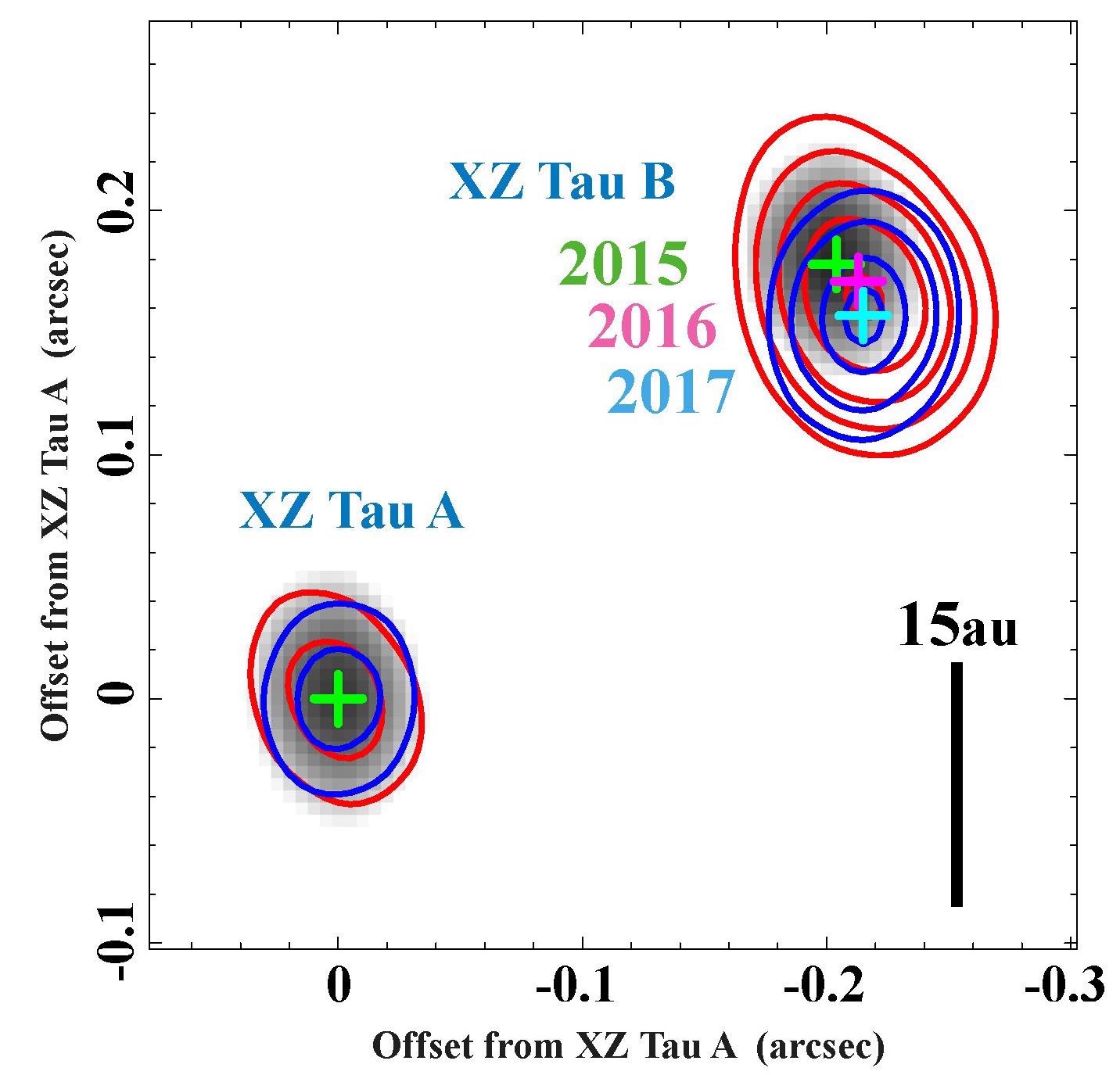The accumulated data from the Atacama Large Millimeter/submillimeter Array (ALMA) was quantified by researchers to portray the motion of a young twin star system, known as XZ Tauri over three years. This “ALMA Animation” is the first of its kind that could provide new information regarding the origins of the binary stars and the formation of planets around them.
 Orbital motion of the young binary XZ Tau system. The location of XZ Tau A (lower-left) is fixed in the image and the relative motion of XZ Tau B is shown. The distributions of the radio waves from the protoplanetary disks are shown in gray scale (2015), red contours (2016), and blue contours (2017). The location of each star is shown as a plus sign. Image Credit: ALMA (ESO/NAOJ/NRAO), T. Ichikawa et al.
Orbital motion of the young binary XZ Tau system. The location of XZ Tau A (lower-left) is fixed in the image and the relative motion of XZ Tau B is shown. The distributions of the radio waves from the protoplanetary disks are shown in gray scale (2015), red contours (2016), and blue contours (2017). The location of each star is shown as a plus sign. Image Credit: ALMA (ESO/NAOJ/NRAO), T. Ichikawa et al.
This achievement was made possible by the high resolution and rich archival data of ALMA. This research utilized three years of observation data. The results show the feasibility of a new research method using radio astronomical animations instead of conventional images. I hope that this method will help to clarify various astronomical phenomena in the future.
Takanori Ichikawa, Study First Author and Former Graduate Student, Kagoshima University
The Sun is a single star, but the Universe comprises binary stars, where two stars orbit each other. During its youth, every young star in a binary system is surrounded by a protoplanetary disk comprising molecular gas and dust. This disk is considered the site of planet formation. Several planets related to the binary stars have been detected. However, the formation of disks in the binary star system and the formation of planets in those systems are yet to be discovered.
In order to study the formation of planets in binary star systems, it is important to accurately determine the orbital motion of the two stars and the tilt of the individual protoplanetary disks.
Shigehisa Takakuwa, Professor, Kagoshima University
Researchers have proposed a two-formation mechanism for binary systems. The first one is a single large gaseous disk and the second is the fragmentation of the larger molecular cloud due to violent turbulence.
In the first case, astronomers assumed that the orbit of the binary stars and the individual stars lie on the same plane. In the second instance, the binary stars and the plane of the disks are expected to be different. This would impact the final orbits of the planets in binary systems.
The researchers analyzed the ALMS data archive and collated data for the young XZ Tau system taken in 2015, 2016 and 2017. The team keenly analyzed the data for the first time and developed an animation of the orbital motion of the binary stars, which depicted that XZ Tau B moved 3.4 astronomical units around XZ Tau A during these three years which is 3.4 times the radius of Earth’s orbit.
The team was able to determine the three-dimensional structure of the orbit. Further, with the study of the Doppler effect and the distribution of the radio waves from the disk around each star in the XZ system, the researchers identified the remarkable misalignment in the disk with respect to each other and also not in the same plane as the binary orbit.
Earlier ALMA observations have revealed examples of young binary stars with protoplanetary disks tilted with respect to each other. However, for the first time, the orbital motion of a binary system has been clarified, depicting the difference in inclination from that of the circumstellar disks. The outcomes substantiate the idea that the XZ Tau system was formed through molecular cloud fragmentation.
“This is a beautiful example of utilizing the rich ALMA archive. The archive paves the way for young researchers to start conducting cutting-edge research right away,” said Takakuwa.
It is true regarding this study.
I am very honored to contribute to such interesting research as an undergraduate student. I hope to use this experience in my own future research.
Miyu Kido, Study Second Author, Kagoshima University
Journal Reference:
Ichikawa, T., et al. (2021) Misaligned Circumstellar Disks and Orbital Motion of the Young Binary XZ Tau. The Astrophysical Journal. doi.org/10.3847/1538-4357/ac0dc3.